Alesis Recital series shines in the digital piano realm by providing budget-friendly options packed with impressive features.
However, the first version of the Recital left some users wanting more in terms of build quality and sound.
That’s where the Alesis Recital Pro steps in – positioned as the more advanced option with fully-weighted keys. But is the upgrade worth the extra bucks?
Let’s compare the Alesis Recital to its upgraded sibling, the Recital Pro, to see if spending more money translates to a better musical experience. Welcome to Alesis Recital vs Recital Pro!
The Alesis Recital Series

The Alesis Recital Series offers top-notch digital pianos that strike the perfect balance between affordability and advanced features.
Designed to provide an immersive playing experience, these instruments are ideal for beginners and pros alike.
Whether you’re just starting out or a seasoned player, both the Alesis Recital and Recital Pro models are crafted to give you that authentic piano feel. Let’s dive into the details.
Overview of Alesis Recital 61 Digital Piano
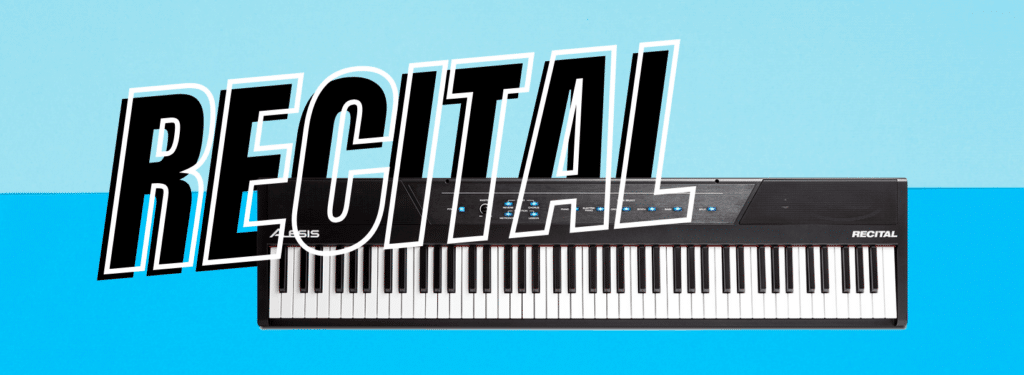
The Alesis Recital 61 Digital Piano offers a premium playing experience with its array of features tailored for both beginners and experienced players alike.
With 61 full-sized semi-weighted keys featuring adjustable touch response, this digital piano ensures a responsive and authentic playing feel.
It boasts 10 built-in realistic voices, which can be customized using Layer Mode to blend two voices together for a rich, full tone. Additionally, Split Mode allows voices to be assigned to either the left or right hand, enhancing versatility during performances or practice sessions.
The Recital’s powerful 20-watt built-in speakers deliver ultra-realistic sound, complemented by adjustable Reverb and Chorus effects to further refine your tone.
With a maximum note polyphony of 128, this digital piano ensures that every note is heard clearly and accurately.
In terms of education features, the Recital includes Lesson Mode, dividing the keyboard into two identical zones for easy teacher-student interaction.
A headphone output allows for quiet, private practice sessions, while connections such as sustain pedal input, stereo RCA outputs, and USB-MIDI output offer versatility in connecting to external devices and software.
Alesis Recital 61 Digital
Piano Package

FEATURES: 20 watts of speaker power
OTHER INFO: Split mode for easy learning and teaching experience
- Adjustable touch response for personalized playing experience
- Layer mode for combining voices
- Reverb and chorus effects for further sound customization
- Built-in speakers for realistic piano sound
- Sustain pedal output for expressive playing
- USB-MIDI output for connecting to a computer and using educational software
- Limited number of built-in voices (10)
- Relatively lightweight construction may not be as sturdy as some models
- Sustain pedal not included (requires separate purchase)
- Metronome tempo range may not accommodate all styles of music
When you click ‘Check Price’, you’ll see there are loads of great places to buy this item. Our personal favorite is Sweetwater for the US, and Thomann and Gear4Music for the UK & Europe.
They are the largest music retailers, with excellent customer service, competitive prices, really fast shipping, and the longest guarantees.
The professional musician who wrote this article combined many things,
from the product build, manufacturer’s reputation through to feedback
from other users, to create our famous TedScore™.
Pros and Cons of Alesis Recital 61 Digital Piano
- Portability: Lightweight and easily portable, making it suitable for traveling musicians or those with limited space.
- Affordable: Provides good value for the price, offering features comparable to more expensive models.
- Variety of Voices: Comes with multiple voices, including piano, which sound realistic and offer versatility in playing different styles of music.
- User-Friendly: Simple to operate, making it accessible for beginners or those returning to playing after a hiatus.
- Decent Sound Quality: The 20-watt speakers produce satisfactory sound, suitable for practice sessions and small performances.
- Educational Features: The inclusion of educational features such as lesson modes, metronome, and recording capabilities makes it an excellent choice for students and those learning to play the piano.
- Key Action: The key action may not be as responsive or realistic compared to higher-end digital pianos or acoustic instruments, which could be a drawback for more advanced players.
- Limited Voices: Offers only five voices, lacking some options like a harpsichord that could enhance musical exploration.
- Metronome Inconvenience: Adjusting the metronome can be cumbersome, and the initial beat sound may be annoying.
- Limited Polyphony: With a polyphony of 128 notes, the Alesis Recital 61 may struggle to sustain complex passages, particularly in more advanced pieces or layered compositions.
- Plastic Key Feel: Keys have a plastic and squishy feel, reminiscent of toy keyboards, rather than the weighted feel of a traditional piano.
- Key Spacing Issues: Some keys are not uniformly spaced, and keys may shift over time, affecting playability.
Overview of Alesis Recital Pro 88 Note Digital Piano
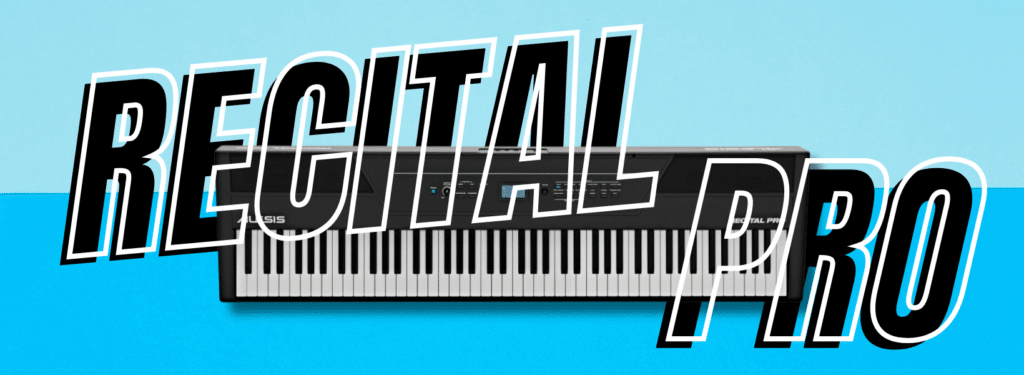
The Alesis Recital Pro 88 Note Digital Piano represents a significant advancement over its predecessor, the original Recital model.
With a host of upgrades, this digital piano offers an impressive array of features at an accessible price point.
One of the standout features of the Alesis Recital Pro is its premium hammer-action keys, which replicate the feel of playing on an acoustic piano.
This weighted keybed provides a responsive touch and allows for expressive playing, making it ideal for pianists who require a high level of control over dynamics and articulation.
In addition to its realistic keybed, the Recital Pro boasts an extensive array of sounds and voices, including acoustic piano, electric piano, organ, and synth, among others.
These voices are meticulously sampled to deliver authentic and lifelike tones, allowing players to explore a wide range of musical genres and styles.
The Recital Pro also offers a variety of built-in features to enhance the playing experience. These include dual keyboard mode, which allows players to layer two voices simultaneously for a richer sound, as well as split keyboard mode, which divides the keyboard into two sections with different voices assigned to each.
Alesis Recital Pro 88 Note
Digital Piano

FEATURES: Touch Sensitivity (3 types, Off)
OTHER INFO: W x D x H: 51.6” x 13.8” x 5.5” (131 x 35.1 x 14 cm)
- Affordable price
- Full-sized 88-key keyboard
- Convenient battery option for on-the-go practice sessions
- Versatile effects including reverb, modulation, and chorus
- Layer and Split modes enhance practice versatility
- Decent sounds and speakers
- USB connectivity for integration with DAW workflows
- Keys may feel somewhat mushy and lack natural response
- Piano sounds exhibit a slight hollowness and short sample length
- Sustain pedal not included
When you click ‘Check Price’, you’ll see there are loads of great places to buy this item. Our personal favorite is Sweetwater for the US, and Thomann and Gear4Music for the UK & Europe.
They are the largest music retailers, with excellent customer service, competitive prices, really fast shipping, and the longest guarantees.
The professional musician who wrote this article combined many things,
from the product build, manufacturer’s reputation through to feedback
from other users, to create our famous TedScore™.
Pros and Cons of Alesis Recital Pro 88 Digital Piano
- Fully weighted keys: The Alesis Recital Pro offers 88 fully weighted keys, providing a more realistic playing experience compared to its semi-weighted counterparts in the same price range.
- Improved build quality: While not perfect, the Recital Pro's build quality is better than the original Recital, addressing issues like creaking and using more durable materials.
- Expanded sound options: With 12 preset tones and effects like reverb, chorus, and modulation, the Recital Pro offers a variety of sound customization options.
- Ample polyphony: With 128-note polyphony, the Recital Pro ensures that even complex pieces can be played without notes cutting off prematurely, a feature typically found in higher-priced keyboards.
- Powerful speakers: Equipped with dual 10W woofers and dual 20W tweeters, the Recital Pro's speakers deliver clear, distortion-free sound even at higher volumes, enhancing the playing experience.
- Battery option: Weighing just 26 pounds and powered by either a 12V DC power supply or 6 D-cell batteries, the Recital Pro is lightweight and portable, making it suitable for both home and on-the-go use.
- Versatile connectivity: Stereo 1/4 inch (6.35mm) outputs, USB-MIDI output, and headphone jack output provide flexibility for connecting to external devices and software, expanding the piano's capabilities.
- Key action issues: Despite being fully weighted, the keys still suffer from a lack of realism, with a mushy feel and difficulty in accurately judging actuation points.
- Limited features: The Recital Pro lacks advanced features found in higher-end digital pianos, limiting its versatility and appeal for more experienced players.
- Absence of certain connections: The lack of an auxiliary stereo mini jack means users cannot easily practice with backing tracks from external devices, limiting its usability in certain scenarios.
Key Features Comparison
Sound Quality and Sampling
When comparing the Alesis Recital 61 Digital Piano Package to the Alesis Recital Pro 88 Note Digital Piano, one of the crucial factors to consider is the sound quality and sampling capabilities.
Both models utilize sampling technology for tone generation, the Alesis Recital Pro takes the lead with its more varied sound library. With 12 different voices compared to the Alesis Recital’s 10, the Pro model offers a wider range of tones, including various types of pianos, synths, bass, and string sounds.
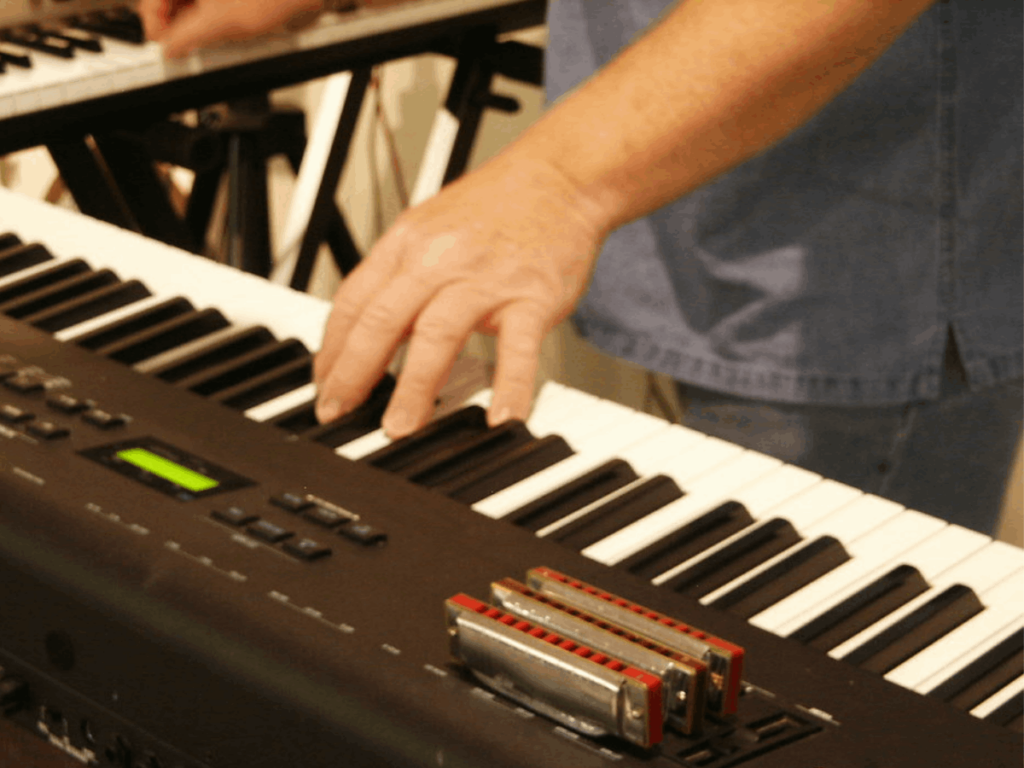
This provides users with more versatility and options for creating unique musical arrangements.
Additionally, while both models boast high-quality samples with natural decay for a realistic acoustic piano sound, the Recital Pro’s sound library offers more depth and richness, making it a better choice for performing pianists or serious students looking to explore different musical styles.
Keyboard Action and Feel
In terms of keyboard action and feel, both the Alesis Recital 61 and the Recital Pro feature weighted keys for a more authentic playing experience.
However, it’s important to note that the Recital Pro offers fully-weighted keys, whereas the Recital 61 has semi-weighted keys.
This means that the keys on the Recital Pro have a more realistic resistance and response, simulating the feel of an acoustic piano more closely.

Despite this, both models share the same hammer action technology, resulting in similar playability between the two.
However, it’s worth mentioning that both models have received criticism for their lackluster key texture, with glossy keys that may detract from the overall playing experience.
Built-in Sounds and Effects
When it comes to built-in sounds and effects, the Alesis Recital Pro once again outshines the Recital 61 Digital Piano Package.
While both models come equipped with built-in effects such as reverb and chorus, the Recital Pro offers additional modulation effects for added versatility in tone shaping.
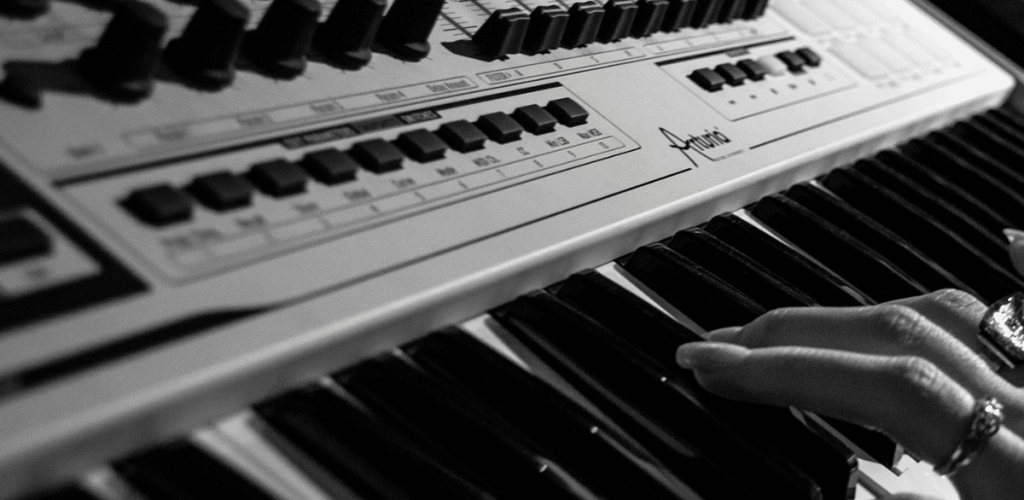
With chorus and modulation effects alongside reverb, users have more options for customizing their sound and creating unique musical textures.
Additionally, the Recital Pro’s wider sound library with 12 voices provides users with more variety and flexibility when selecting tones for their compositions or performances.
Connectivity Options
Both models offer versatile connectivity options, including a 1/4 inch sustain pedal output and USB-MIDI output for connecting to a computer.
Additionally, the Recital Pro features stereo 1/4 inch outputs for connecting to external devices such as mixers, amplifiers, or speakers, offering more flexibility in performance settings.
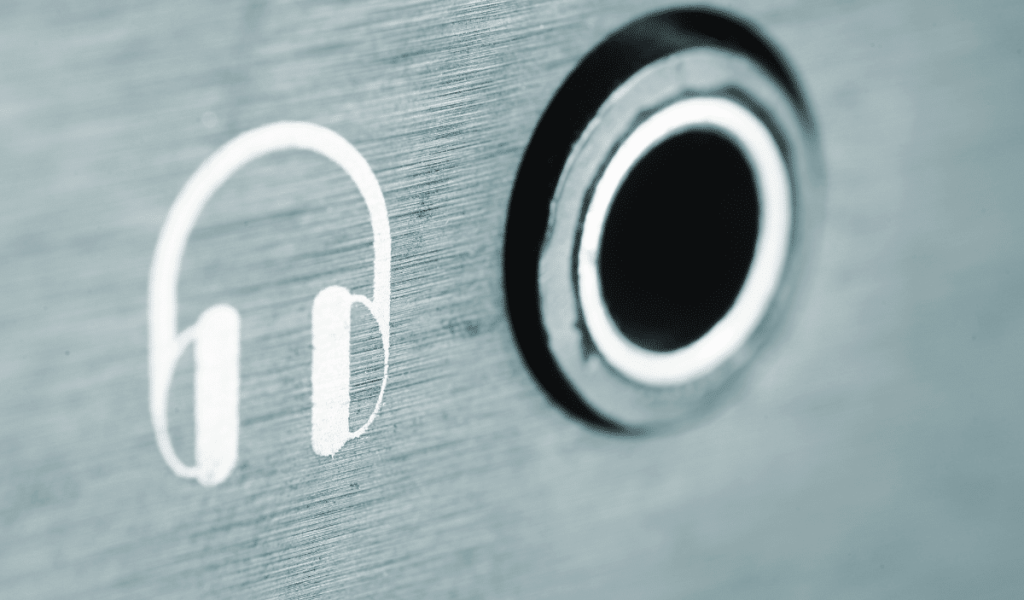
However, both models lack built-in Bluetooth connectivity, which may be a consideration for users seeking wireless compatibility.
Additional Features and Functions
Both the Alesis Recital 61 and Recital Pro come equipped with powerful education features, including a “learn mode” for interactive learning and a built-in adjustable metronome for timing practice.
The Recital Pro offers additional features such as a headphone output for private practice and a sustain input for connecting a standard pedal.
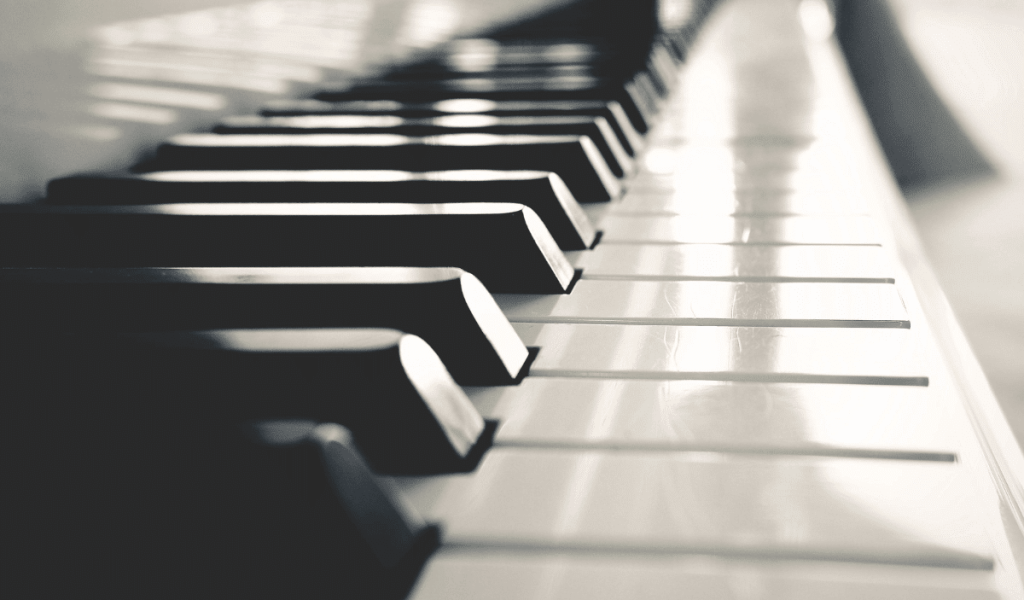
Furthermore, the Recital Pro includes three free months of Skoove Premium, providing users with access to a wide range of online piano courses.
Price and Value Considerations

When considering price and value, it’s important to weigh the features and capabilities of each model against their respective price points.
The Alesis Recital 61 Digital Piano Package may be more affordable than the Recital Pro, the latter offers significantly more features and functionality for a relatively modest increase in price.
With its fully-weighted keys, wider sound library, additional effects, and educational resources, the Recital Pro represents a better overall value proposition for users who are serious about learning or performing the piano.
User Experiences and Reviews
User experiences and reviews can provide valuable insights into the performance and usability of both the Alesis Recital 61 and the Recital Pro.
Individual opinions may vary, many users have praised the Recital Pro for its realistic feel, versatile sound library, and educational features.
However, some users have noted issues with the key texture and sound system of both models, suggesting that improvements could be made in these areas.
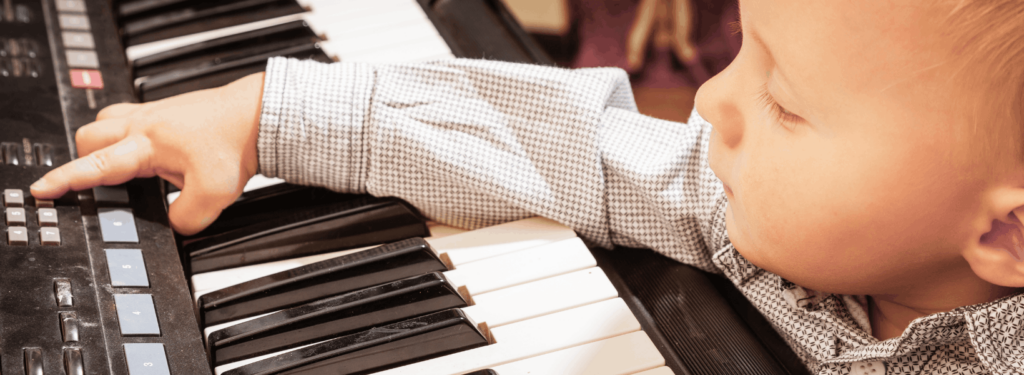
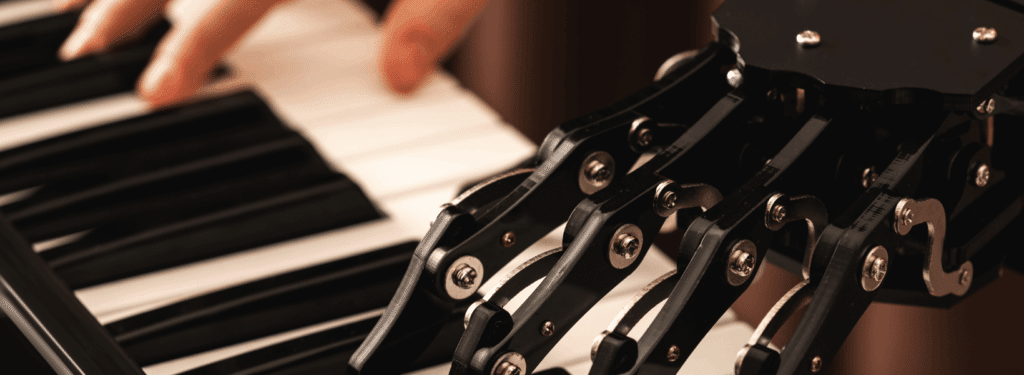
Ultimately, prospective buyers may wish to try out both models for themselves or research user reviews to determine which option best meets their needs and preferences.
Which One Should You Choose?

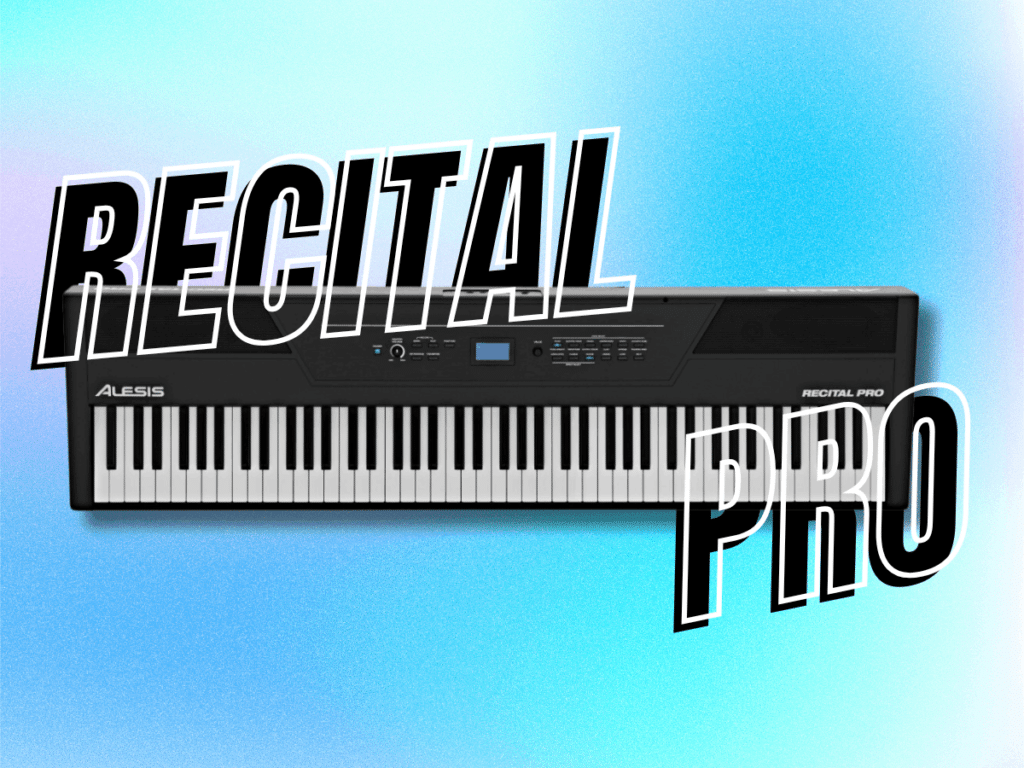
Choosing between the Alesis Recital and the Recital Pro depends on your specific needs and preferences.
If you’re a beginner seeking a budget-friendly option with basic features, the Alesis Recital is a reliable choice.
It provides semi-weighted keys and a decent selection of voices, making it suitable for entry-level players.
However, if you’re looking for a more authentic piano-playing experience and enhanced performance capabilities, the Alesis Recital Pro emerges as the superior option.
With fully-weighted keys, a wider sound library, and additional piano features, the Recital Pro caters to players who are serious about learning and improving their piano skills.
Alesis Recital Vs Recital Pro
Summary
The Alesis Recital and Recital Pro both offer distinct advantages, catering to different preferences and skill levels.
While the Alesis Recital provides a solid entry point with its affordability and basic features, the Recital Pro elevates the experience with fully weighted keys, a wider sound library, and additional piano features.
For beginners seeking an accessible starting point, the Recital is a reliable choice. However, for those looking for a more authentic piano-playing experience and enhanced performance capabilities, the Recital Pro emerges as the superior option.
And it’s the Recital Pro that I personally love playing on.
Now that you’ve learned about the differences between these two models, which one do you think would best suit your needs and preferences?
FAQ's
The Alesis Recital Pro offers fully weighted keys for a more realistic piano-playing experience, while the original Recital has semi-weighted keys. Additionally, the Recital Pro has 12 built-in voices compared to the Recital’s 10, providing a wider variety of sounds for enhanced creativity and versatility in performance or composition.
Yes, the Alesis Recital Pro features fully-weighted keys, providing a realistic playing experience similar to that of an acoustic piano.
The Alesis Recital is a good keyboard, especially for beginners. It offers an affordable option with 88 semi-weighted keys, suitable for learning and practice. It also includes useful features such as lesson mode and built-in effects like reverb.
The Alesis Recital Pro does not come with a sustain pedal included. However, it does have a ¼” sustain pedal input, allowing you to connect an external sustain pedal for added expression while playing.
The Alesis Recital Pro offers a significant upgrade over the standard Recital model, with a richer sound library, more piano features, and additional effects. While it comes at a higher price point, it provides excellent value for beginners and aspiring pianists looking for a versatile digital piano.
With its fully-weighted keys, adjustable touch response, and various playing modes, the Recital Pro is a worthy investment for those serious about learning and improving their piano skills.



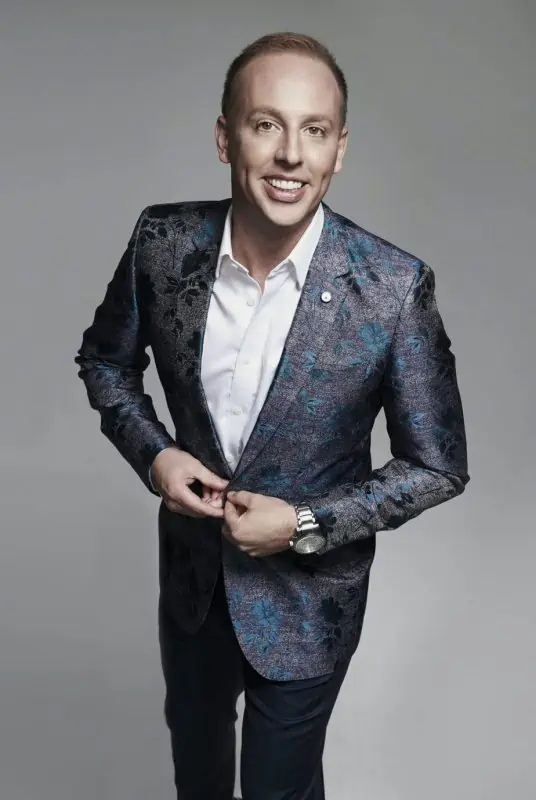






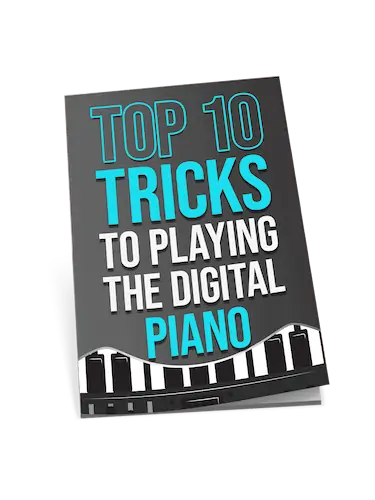
So, we’re saying that the Recital 61 is the budget-friendly choice for those of us who value portability over an authentic piano feel? How… economical.
Has anyone compared the output of these pianos in a studio setting? Wonder how they record compared to more expensive keyboards. Thanks for the insights, Robert!
No problem…
They actually hold up pretty well, especially for the price point. Not top of the line, but definitely usable for studio work. Used them on a few tracks myself.
Great to see Alesis providing solid options in the digital piano space. The built-in sounds and effects section caught my interest – always on the lookout for instruments that can provide unique textures.
While the comparison is appreciated, personal experience varies significantly. I found the key action on the Recital Pro to be better than described, possibly due to recent improvements. Would recommend individuals to try it firsthand.
Got to call out a possible oversight – the article doesn’t thoroughly examine the latency of the digital output on these pianos. For live applications, that’s a make or break feature.
If the Alesis Recital had a matchmaking profile, it would say ‘Good looking with a great personality but a bit heavy to move around’. Lol!
Really appreciate the breakdown between the Recital and Recital Pro. Being a guitar player, I’m new to the piano world, and this article helped me understand which Alesis model might suit me better as I start this new journey.
I think you’re missing the point on the sound quality. Most beginners aren’t gonna notice the difference in sound sampling. It’s all about the feel and learning curve.
Actually, the quality of sound can greatly impact a beginner’s ear training and overall musical development. Don’t underestimate it!
Always been a fan of the Alesis gear but never tried their digital pianos. Good to see they’ve got the connectivity options covered, making it easier to integrate with the rest of my setup. Interesting read!
Was wondering about the action of the keys on the Recital Pro compared to an acoustic. Do they feel responsive enough for dynamics? Cheers, Robert Emery for the detailed review!
No worries.